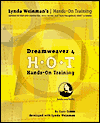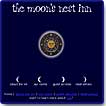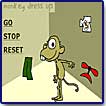Dreamweaver
4 Hands-On Training
"A
Fantastic Book For Learning Dreamweaver 4!"

Title:
Dreamweaver
4 Hands-on Training
Author: Garo
Green, Lynda Weinman
Publisher:
Peachpit Press http://www.peachpit.com
Publication Date: May
2001
Pages: 650
with CD
ISBN: 0-201-74133-4
Price:
$39.99
Dreamweaver 4 Hands-On-Training is the newest version of the Hands-on-Training series book for Macromedia's Dreamweaver 4, a WYSIWYG HTML editor. The book is structured as a series of exercises that explore Site Management; Layers; Tables, including the new Layout Tables feature; Tracing Images; Cascading Style Sheets; Libraries/Templates, including the new Assets Panel; Frames; Rollovers; Forms Design; Interactivity; Sound/Plug-Ins; and much more. The authors didn't set out to cover every single aspect of Dreamweaver, but wanted to write a book which was a process-oriented tutorial that taught readers core principles, techniques, and tips in a hands-on training format. So this book is full of insider tips, illustrated with detailed graphics, and is accompanied by a CD-ROM that's loaded with guided exercises and QuickTime moves.
This book is appropriate for both PC and Macintosh users. Check out the Peachpit Press Web site (http://www.peachpit.com) for more information about the book and other books in the Hands-On-Training series. Also check out Lynda Weinman's Web (http://www.lynda.com) site for information on her other books and classes.
What I like:
- Step-by-step instruction;
- Even more exercises in this version than in the last;
- Screen shots on almost every page;
- Notes, Tips, and charts galore;
- CD full of extra goodies and demo software.
Dreamweaver 4 Hands-on Training is divided into an introduction, 19 chapters or lessons and an appendix.
Introduction--describes basics about how the book works and background on the authors.
Chapters 1 through 19 cover the following:
- Chapter 1: Background--presents information on: Roundtrip HTML; HTML; File Naming; Extending Dreamweaver; DHTML; XML; and JavaScript. The chapter Includes a very clear description of what HTML is and provides two visual charts. There are two lists, one for online HTML resource sites and another for Dreamweaver shared resource sites. It includes helpful charts on file-naming conventions; filename extensions; and DHTML terms.
- Chapter 2: Interface--discusses: Interface Tour; Objects Panel; Launcher and Mini-Launcher; Customizing the Launcher; Properties Inspector; Document Window; Toolbar; External Editors; and Preferences. Includes screen shots of the interface and types of objects. This chapter has excellent charts of Object Panel types; Launcher and Mini-Launcher features; launcher shortcuts; toolbar features; document window features; and shortcuts.
- Chapter 3: Site Control--covers: Defining a Site; Relative and Absolute Links; File and Folder Management; Understanding Paths; Different Path Notations; and Site Maps. Very important chapter on the necessity of defining a site in Dreamweaver with a root folder so that Dreamweaver can automatically update your pages when you add, modify, move, or delete files or folders. There is a chart on path notations and an excellent notation explaining absolute vs. relative URLs. It includes six exercises.
- Chapter 4: Basics--presents information on: File Name Versus Title Name; Significance of index; Html; Inserting Images and Text; Page Properties; Links; Meta Tags, and Looking at HTML. Walks you step-by-step through the process of creating a Web page with images, links, and meta tags. It includes charts on color picker options and page properties. It includes ten exercises.
- Chapter 5: Linking--provides information on: Linking with Point to File; Browse for File and Link History; Linking to New Source Files; Email Links; Named Anchors; and Image Maps. There are no charts but it does have a great section on anchors with screenshots which simplify the process. It includes seven exercises.
- Chapter 6: Typography--shows: Creating and Formatting HTML Text; Font Lists; Aligning Text; Text and Images; Ordered, Unordered, and Definition Lists; Color Schemes; Formatting Text in Tables; Applying HTML Styles; Character Entities; and creating Flash Text. Informational charts of system fonts; font sizes; HTML text and image alignment definitions; ordered, unordered, and definition lists; HTML styles; character entities; and using Flash text are included. There are ten exercises.
- Chapter 7: Tables--gives you information on: Changing the Border of a Table; Sorting the Table; Changing the Color Scheme; Creating and Modifying a Table; Percentage-Based Table Alignment; Seamless Image Assembly; Combining Pixels and percentages; Inserting Tab-Delimited Data; Nested Tables and Borders; and Rounded Corner Tables. Useful step-by-step instructions on sorting the contents of a table and creating an image map. There are charts on anatomy of a table; sorting features; cellpad versus cellspace; and tabular data settings. It includes eleven exercises.
- Chapter 8: Layout--discusses: Applying a Tracing Image; Tracing Images, Background Colors, and Images; Adding Layers; Converting Layers to Tables; Converting Tables to Layers; Using Margin Tags; Layout Tables and Layout Cells. The chapter includes charts on tracing images, layers, and tables defined; convert layers to table options; layers to tables versus layout view; and layout view vs. standard view. It includes six exercises. See top image to the left for a view of a file that you work with.
- Chapter 9: Frames--covers: What Are Frames; Saving Your First Frameset; Different Ways to Save Frames; Coloring Frames; Links and Targets; Adding a Background Image; Seamless Background Across Two Frames; and Frames Objects Panel. There are charts describing the good and bad features of frames; ways to save frames; HTML specifications for target names; frame size settings; and frames properties. Informative chapter on a difficult subject. The author hits on the basics without overwhelming you with detail. There are six exercises.
- Chapter 10: Rollovers--describes: Creating a Simple Rollover; Animated Rollovers; Creating Pointer Rollovers; Creating Multiple-Event Rollovers; Inserting a Navigation Bar Rollover; Rollover States; Creating Flash Buttons; and Inserting a Simple Rollover from Fireworks. There are charts describing: swap image at a glance, creating Flash buttons; using Flash text; rollover states, and adding elements to the navigation bar. It includes seven exercises.
- Chapter 11: Cascading Style Sheets--provides information on: Redefining HTML with Style Sheets; Defining a Custom Class; Using Selectors to Group Tags; Affecting Links with Selectors; Linking to a Style Sheet; and Converting from CSS to HTML. Excellent step-by-step tutorials for making the three types of style sheets and then converting styles back to HTML. There is are charts on types of style sheets and creating styles in Dreamweaver. There are six exercises.
- Chapter 12: HTML--includes information on: Code View; Editing in the Code View; Using the Quick tag Editor; Cleaning Up HTML; and Cleaning Up Word HTML. It includes charts on code view options and the different selections available under the Clean Up HTML command. It also has five exercises.
- Chapter 13: Forms--provides information on: Working with Form Objects; Creating a Form; and Creating a Jump Menu. The chapter has a chart for form objects. Again, the author makes this task look simple. There are three exercises.
- Chapter 14: Behaviors--presents information on: Creating a Check Browser Behavior; Creating a Set Text of Status Bar Behavior; Creating a Set Text of Text Field behavior; Opening a New Browser Window; Validating Forms with Behaviors; The Macromedia Exchange--Dreamweaver; Installing the Macromedia Extension Manager; Inserting ImageReady HTML; and Downloading from Macromedia Exchange. It includes a chart to add the Set Text of Text Field Behavior. There are eight exercises.
- Chapter 15: DHTML--describes: Dragging Layers; Using Timeline for Animation; Playing, Stopping, and Resetting the Timeline; and Creating a DHTML Pop-Up Menu. The chapter shows you what you can do with DHTML in a straightforward manner. There is a chart for timeline features and four exercises. See bottom image to the left for a view of a file that you work with.
- Chapter 16: Automation--includes information on: Using the History Panel for Undo/Redo; Copying and Pasting History; Creating Custom Objects; Creating a Web Photo Album; and Optimizing Images in Fireworks. There are no charts but it has five exercises.
- Chapter 17: Templates/Libraries--discusses: Creating and Modifying Templates; Library Items in Action; Creating and Modifying a Library Item. Step-by-step instructions are easy to follow and make creating and modifying templates a snap. There are no charts. It includes six exercises.
- Chapter 18: Plug-Ins--covers: Linking to Sounds; Embedding Sounds; Inserting Flash Content; Inserting Director Content (Shockwave); and Inserting QuickTime Content. This chapter includes charts for URLs for downloading plug-ins; sound formats; and what QuickTime supports. There are five exercises.
- Chapter 19: Getting It Online--describes: Free Web Hosting with GeoCities; Setting the FTP Preferences; Putting Files onto the Web Server; Getting Site Reports; and the Reports Dialog Box. There are charts for FTP settings in Dreamweaver and report dialog box options. It has four exercises.
- Appendix A: A Troubleshooting FAQ: gives you frequently asked questions and answers.
- Appendix B: Online Resources: provides online sources.
- Appendix C: Technical Support: gives you all the information on where to get technical support.
For running Dreamweaver 4, you need:
PC:
- Intel Pentium process or equivalent, 166 MHz or faster, running Windows 95, Windows 98, Windows 2000, Windows ME, or Windows NT (with Server Pack 5);
- Version 4.0 or later of Netscape Navigator or Microsoft Internet Explorer;
- 32 MB of random-access memory (RAM) plus 110 MB of available disk space;
- 256-color monitor capable of 800 x 600 pixel resolution;
- CD-ROM drive.
Macintosh:
- Power Macintosh running Mac OS 8.6 or 9.x;
- 32 MB of random-access memory (RAM) plus 135 MB of available disk space;
- 256-color
monitor capable of 800 x 600 pixel resolution;
CD-ROM drive.
Web Page Design: Macromedia Dreamweaver 4.0
| Educational | Books | Utilities | Web Tools | Legal | Articles

